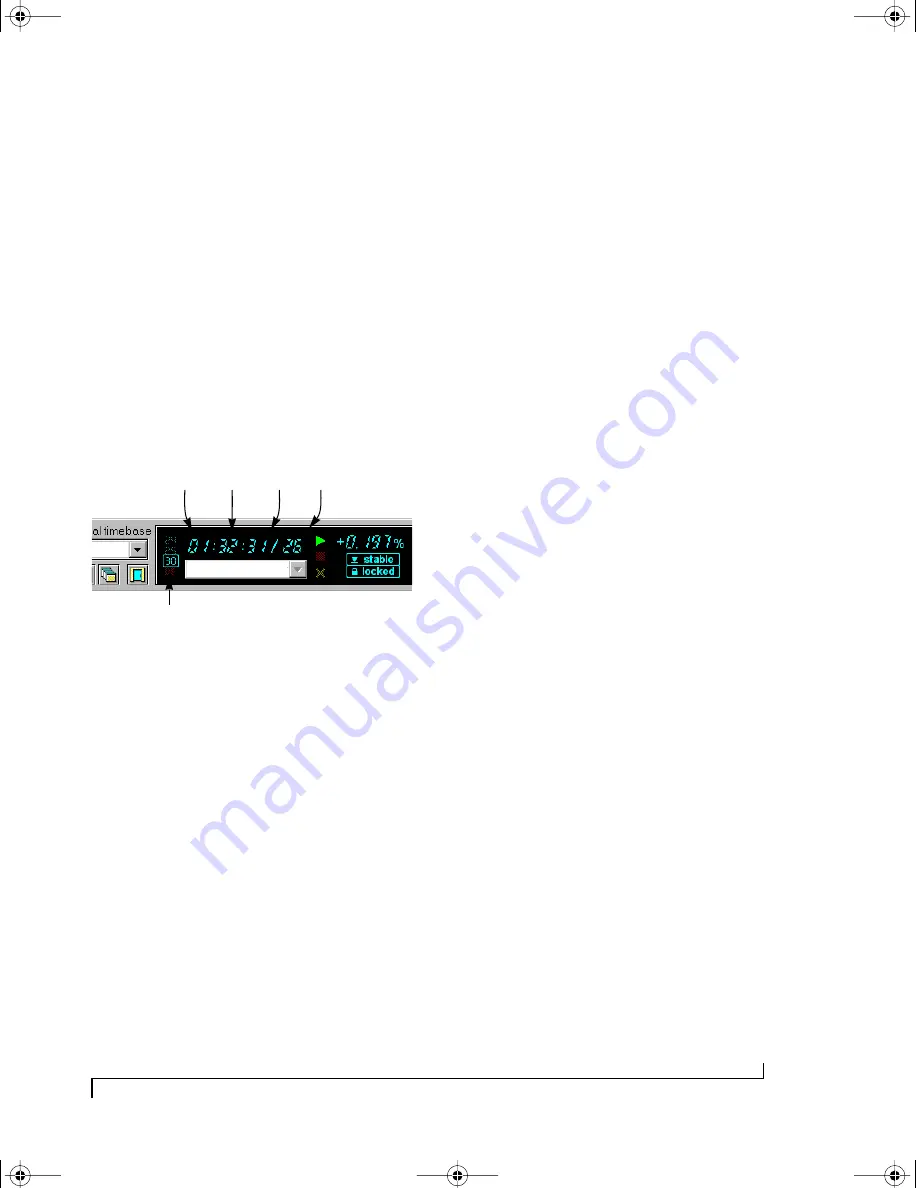
U S I N G M I D I E X P R E S S X T C O N S O L E
53
selected Setup. You can also use the keyboard up
and down arrow keys to scroll through the list,
pressing Enter to select the desired Setup.
Alternately, you may use the MIDI Express XT’s
front panel buttons to change Setups. At all times,
the Console should remain “in sync” with your
MIDI Express XT, accurately displaying the
current Setup configuration.
The SMPTE readout
To the right of the Setup list is the SMPTE readout.
The SMPTE readout always gives a real time,
running update of the current frame time and
frame rate when your MIDI Express XT is
converting or generating SMPTE timecode.
Figure 7-4: The SMPTE readout in the toolbar sync display.
Below the SMPTE readout is the SMPTE error list.
This list will display any “dropouts” and MIDI
errors encountered while converting incoming
SMPTE. Each dropout will be shown with the last
valid SMPTE time converted before the dropout
occurred and the number of frames missing after
that time. The list will be cleared each time new
timecode begins. Hopefully, you will not see too
many entries appear in this list. However, if you do,
the MIDI Express XT has a flexible SMPTE free-
wheeling (“jam-syncing”) capability to smooth out
problem sync tracks (you can also use the MIDI
Express XT as a SMPTE regenerator/reshaper to
re-record or extend sync tracks).
ExpressHelp
You’ll also notice a bar along the bottom of the
main Console window. This is the status bar where
notification and progress messages will be
displayed from time to time while the Console
performs its various functions. In addition,
another feature of the Console uses this area for
displaying “ExpressHelp”. ExpressHelp consists of
short, informative messages that change
depending on which Console control (button, list,
etc.) the on-screen mouse cursor is on top of.
ExpressHelp will also update if you shift the control
focus using the Windows keyboard interface (using
the Tab key in a console window, for example)
instead of using the mouse.
ExpressHelp is enabled by default to aid you in
getting familiar with the Console, but you may
disable it with the Options menu selection.
MIDI EXPRESS XT MIDI PROCESSING
Before going any further, it is important to
understand how the MIDI Express XT performs its
MIDI processing, specifically the order in which
each type of processing is applied. Figure 7-5
illustrates how the Express XT processes MIDI
data as it travels from one interface input port to
one interface output port.
First, data is received from an input port, where it is
immediately filtered (events that are filtered are
removed). Next, the remaining events are
channelized (“mapped”) to different channels (the
default is no channelizing) and then they are sent to
the “data bus”. The data bus is where port-to-port
routing takes place, sending MIDI data from each
input to any combination of outputs. When the
data finally reaches its destination output port(s), it
is channelized and filtered again before leaving the
MIDI Express XT. All of this processing power is
completely configurable from the Console.
SMPTE frame rate
hours
minutes
seconds
frames
!USB Interfaces Manual Book Page 53 Tuesday, October 10, 2000 12:43 PM
Summary of Contents for micro express-USB
Page 1: ...C M Y CM MY CY CMY K...
Page 6: ...IV USB Interfaces Manual Book Page iv Tuesday October 10 2000 12 43 PM...
Page 7: ...All Users PartI ForAllUsers USB Interfaces Manual Book Page 5 Tuesday October 10 2000 12 43 PM...
Page 8: ...All Users USB Interfaces Manual Book Page 6 Tuesday October 10 2000 12 43 PM...
Page 28: ...XT Micro Users USB Interfaces Manual Book Page 26 Tuesday October 10 2000 12 43 PM...
Page 84: ...MPT AV Users USB Interfaces Manual Book Page 82 Tuesday October 10 2000 12 43 PM...
Page 142: ...Appendices USB Interfaces Manual Book Page 140 Tuesday October 10 2000 12 43 PM...






























